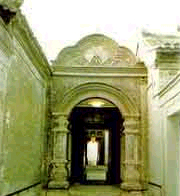 Courtyards are perhaps the most famous and celebrated form of residential architecture in China. The most famous courtyards in North China are in Shanxi Province, in particular the Qiao Jia courtyard which Zhang Yimou used in his acclaimed film Raise the Red Lantern. The Wang Jia Courtyard is even bigger and more magnificent and Kong Jia courtyard has its own unique characteristics.
Courtyards are perhaps the most famous and celebrated form of residential architecture in China. The most famous courtyards in North China are in Shanxi Province, in particular the Qiao Jia courtyard which Zhang Yimou used in his acclaimed film Raise the Red Lantern. The Wang Jia Courtyard is even bigger and more magnificent and Kong Jia courtyard has its own unique characteristics.
But it isn’t necessary to voyage all the way to Shanxi for a look at courtyard culture. Shi Jia Courtyard in Tianjin is actually the biggest surviving courtyard in China.
In 1994, Zhang Yimou returned to a courtyard set for Huo Zhe (To Live). The film may have lost out to Quentin Tarantino’s Pulp Fiction for the Cannes Film Festival’s main prize, but it was still awarded the Grand Prix de Jury, the first Chinese film to pick up this aw. Many scenes were shot in the Shi Jia Courtyard.
The courtyard is located in the Town of Yang Liu Qing near Tianjin city. Yang Liu Qing is famous for the making and printing of Chinese folk-style calendars. The Shi Jia Courtyard now hosts the Yang Liu Qing Museum of Tianjin.
The Shi Family
The Shi family was one of the eight most famous and powerful families in Tianjin in the late Qing Dynasty. The Shi family first became rich through trading grain and cotton, using the canal transportation that was popular at that time. They made enough money to buy land and build their own houses. Then they opened shops, factories and private banks to multiply their wealth. The family lived in Yang Liu Qing for over 200 years. During the reign of emperor Jia Qing, the Shi family owned thousands of hectares of land and 500 houses.
Architecture
The Shi Jia Courtyard was first built in 1875. With a total area of about 6,080 square meters, the whole complex includes 12 smaller yards and 278 rooms.
Entering the courtyard from Gu Yi Street you can see a long paved path leading to the far end of the yard. The path is the axis of the whole yard, wave smaller yards on either side. Every yard has its own gate to the path so that they stand-alone but are well connected by the long path. This is the typical structure of courtyards owned by rich families in the Qing Dynasty.
The yards were all built for different purposes. Living rooms for different members of the family, reception halls of various sizes for different guests, a number of studies and various other rooms are all organized along the long path. There is even a theatre in one of the yards. This is the biggest theatre of any civilian residence in North China and used to host some famous Peking Opera performers.
Museum
The Yang Liu Qing Museum in the Shi Jia Courtyard has a good collection of traditional craftwork. Brick sculpture is a form of decoration on many ancient Chinese buildings. In the museum more than 130 pieces of brick sculpture are on display. Delicate human figures, flowers and pagodas are carved on the bricks. A former guest room has been restored to its original appearance and has become another section of the museum for the display of some precious art collections of the Shi family. A folding wooden screen is considered to be extremely valuable.
Yang Liu Qing wood-carved calendars are an important local art form and are famous all around China. Having originated in late Ming Dynasty, the calendars became widely popular during the reigns of Yong Zheng and Qian Long during the Qing Dynasty. The calendars vary greatly with themes like historical stories, fairy tales, landscapes or flowers. The making of a Yang Liu Qing calendar is a complicated process involving delicate painting on each piece after a process of wood-carving and printing. Most of the families in Yang Liu Qing are capable of producing this beautiful artwork.
Transportation:
T533 Intercity express train, Beijing 9:27am, arrival at Tianjin Station, fare 35 yuan;
K45 Air-conditioned train, Beijing 9:03am, arrival at Tianjin West Station, fare 24 yuan;
Get to Shi Jia Courtyard from the West Station by direct bus No. 153. The 60-minute ride costs 2 yuan.
Admission Fee to the Courtyard:
10 yuan
Nearby Sightseeing:
When the tour in the Shi Jia Courtyard is finished, tourists still have a few other places to visit. During the great Ping Jin (Beijing and Tianjin) campaign in the civil war more than 50 years ago, the Tianjin front command of the PLA was positioned in Yang Liu Qing. Now the site of the command is on display to the public. Admission fee: 1 yuan.
You can also visit Xiao Nan He in the Xi Qing District to see the residence of Huo Yuan Jia and his tomb. Huo was a famous warrior and master of Chinese Kungfu.
(Beijing Portal November 20, 2002)
|

